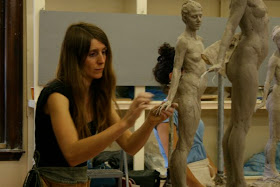"Graydon's class is amazing. He is more logical and systematic about his palette and how he mixes his colors than anyone I've met. He uses the Munsell system to completely explain what light and color do to our eyes in reality. He boils everything down to three major factors. It's all hue, value and chroma and there's nothing else. That's all that color is. That's all that painting is.
 On the first Friday of the workshop, we went to the Met to analyze the Master Painters and to objectively evaluate how they were using color.
On the first Friday of the workshop, we went to the Met to analyze the Master Painters and to objectively evaluate how they were using color.  Back in the studio, Vivian uses the colormunki to scan the local of Greg's hair. We did not test the image on his t-shirt. We did test his arm, though.
Back in the studio, Vivian uses the colormunki to scan the local of Greg's hair. We did not test the image on his t-shirt. We did test his arm, though. This is a trompe l'oeil painting of high chroma paper strips done by a workshop participant. Everybody who takes this workshop for the first time does this exercise. It is meant to show how chroma and value decrease as light decreases.
This is a trompe l'oeil painting of high chroma paper strips done by a workshop participant. Everybody who takes this workshop for the first time does this exercise. It is meant to show how chroma and value decrease as light decreases.  A color wheel that shows each hue in its highest chroma. This is also an exercise for first time participants. This was my second time taking the workshop, and I worked on a more advanced project.
A color wheel that shows each hue in its highest chroma. This is also an exercise for first time participants. This was my second time taking the workshop, and I worked on a more advanced project.  This is my palette. I have mapped out the various strings for different flesh tones in different ranges. From left to right it moves through value. From top to bottom it moves through chroma. All the colors were mixed to match the chips sitting on the right of the palette.
This is my palette. I have mapped out the various strings for different flesh tones in different ranges. From left to right it moves through value. From top to bottom it moves through chroma. All the colors were mixed to match the chips sitting on the right of the palette. Graydon helped me to map out all the pigments in my paint file and figure out exactly what they were in terms of hue, value and chroma so that I can use them more effectively. We experimented with the ways that different brands and hues stacked up on the actual color wheel. This was the first time Graydon or I experimented with this in this way. We found this to be very enlightening to see the nuance of how different pigments shift as they move through different values and chromas.
Graydon helped me to map out all the pigments in my paint file and figure out exactly what they were in terms of hue, value and chroma so that I can use them more effectively. We experimented with the ways that different brands and hues stacked up on the actual color wheel. This was the first time Graydon or I experimented with this in this way. We found this to be very enlightening to see the nuance of how different pigments shift as they move through different values and chromas.  What intrigues me so much about Graydon and his color theory, is the logic behind it and how he mixes so many different strings on his palette, which all result in a perfect representation of reality."
What intrigues me so much about Graydon and his color theory, is the logic behind it and how he mixes so many different strings on his palette, which all result in a perfect representation of reality."pix also by Devin Cecil-Wishing






































